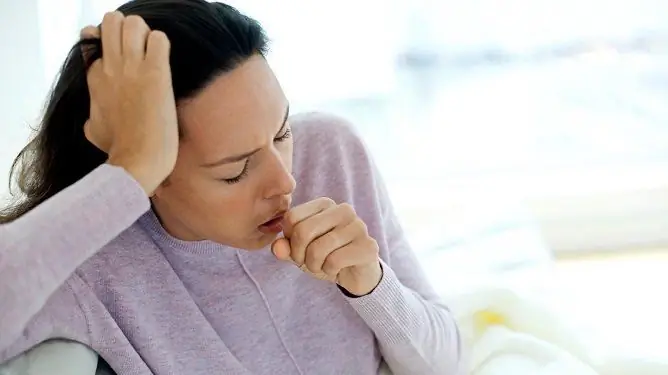- Author Rachel Wainwright [email protected].
- Public 2023-12-15 07:39.
- Last modified 2025-11-02 20:14.
Chest fee number 4
Breast fee number 4: instructions for use and reviews
- 1. Release form and composition
- 2. Pharmacological properties
- 3. Indications for use
- 4. Contraindications
- 5. Method of application and dosage
- 6. Side effects
- 7. Overdose
- 8. Special instructions
- 9. Application during pregnancy and lactation
- 10. Use in childhood
- 11. Drug interactions
- 12. Analogs
- 13. Terms and conditions of storage
- 14. Terms of dispensing from pharmacies
- 15. Reviews
- 16. Price in pharmacies
Latin name: Pectorales species No. 4
ATX code: R05CA10
Active ingredient: chamomile flowers + marsh wild rosemary shoots + marigold (calendula) flowers + violets tricolor grass + licorice roots + peppermint leaves (Chamomilla recutita flores + Ledum palustre germen eius + Calendula flores + Viola tricolor herba + Licoricia radix + Mentha)
Manufacturer: Fitofarm PKF (Russia); Microgen NPO FSUE (Russia); ST.-Medifarm CJSC (Russia); AO Krasnogorskleksredstva (Russia); LLC "Firm" Health "(Russia)
Description and photo update: 2019-11-07
Prices in pharmacies: from 27 rubles.
Buy

Chest collection No. 4 is a combined anti-inflammatory, bronchodilator, tonic and expectorant drug.
Release form and composition
Breast collection number 4 is issued in the following forms:
- crushed raw materials: yellowish-green mixture of dissimilar pieces of vegetable raw materials interspersed with reddish-brown, dark green, creamy white, bluish-purple, yellow-orange, grayish-brown, grayish-green and yellowish-gray, passing through holes 7 mm; the water extract is bittersweet in taste, slightly cooling (30, 50, 75 or 100 g each in cardboard boxes with an inner bag, instructions for use are applied to the box or inserted inside the cardboard box);
- collection-powder: a reddish-yellow mixture of heterogeneous pieces of plant material interspersed with white, brown, green and yellowish-orange colors, passing through holes with a diameter of 2 mm; water extract is bittersweet in taste, slightly cooling (1.5 g or 2 g each in heat-sealable filter paper filter bags, in a cardboard box 10, 20, 24, 30 or 50 filter bags, instructions for use Breast collection No. 4 is applied to the box or inserted inside the cardboard box).
Composition of Breast Collection No. 4:
- marsh wild rosemary shoots - 20%;
- chamomile flowers - 20%;
- violet grass - 20%;
- calendula flowers - 20%;
- peppermint leaves - 15%;
- licorice roots - 15%.
Pharmacological properties
Chest collection No. 4 is a combined herbal remedy for bronchodilator, tonic, expectorant and anti-inflammatory action, most often used for coughing.
The effect of the drug is due to the following biologically active substances contained in the herbal ingredients of the collection:
- wild rosemary shoots: poisonous essential oil - from 1.5 to 7% (including bicyclic alcohol, palyustrol, iceol, η-cymene, geranyl acetate, hydrocarbons), which has a bitter-burning taste and a specific balsamic aroma, andromedotoxin, glycosides (arbutin), coumarins (esculetin, scopoletin, esculin, umbelliferon, etc.), tannins, flavonoids (quercetin, hyperoside), phytoncides, vitamin C (ascorbic acid), micro- and macroelements, dyes;
- chamomile flowers: essential oil - 0.2-0.8% (including the main biologically active substance - chamazulene, its precursor, prochamazulene, other monoterpenes and sesquiterpenes), flavonoids (including derivatives of apigenin, quercetin, kaempferol, luteolin, isorhamnetin), coumarins, sesquiterpene lactones (matricin and matricarin), phenol carboxylic acids, phytosterols, choline, organic acids (salicylic, isovaleric, caprylic), carotene, vitamin C, mucus, gums, bitterness, macro- and microelements, polyacetylenes;
- violet herb: alkaloid violaemitin, coumarins, saponins, tannins, flavonoids (violatin, violquercitrin, vitexin, rutin, orientin, etc.), polysaccharides, anthocyanins and leukoanthocyanins, mucus, acids (tartaric, saline-ursolic), macroelements (calcium, potassium, iron, magnesium), trace elements (aluminum, copper, zinc, manganese, cobalt, molybdenum, barium, nickel, selenium, strontium, lead); has the ability to accumulate zinc, iron, molybdenum, selenium, barium;
- calendula flowers: carotenoids - up to 3% (including carotene, violaxanthin, lycopene, rubixanthin, citroxanthin, flavochrom, flavoxanthin, etc., 15 compounds in total), paraffinic hydrocarbons (gentriacontan, sitosterol), triterpene glycosides, resins, organic mucus and bitterness acids (salicylic, malic), vitamin C, triterpene saponins (oleanolic acid glycosides, called calendulosides A, B, C, D, E, F, G, H), flavonoids (isoquercitrin, rhamnetin, isorhamnetin-3-glucoside, and others), alcohols - up to 5%, polysaccharide (containing arabinose, galactose, glucose, rhamnose and xylose), coumarins in small quantities (scopoletin, esculetin, umbelliferone), resinous and tannins - up to 3.44%, traces of alkaloids, trace elements, sterols;
- peppermint leaves: essential oil, the main component of which is menthol (from 40 to 70%) and its esters, limonene, β-pinene, cineole, pulegon, dipentene, and other terpenoids - up to 3%; tannins, organic acids, flavonoids, betaine, carotene, hesperidin, acids (ursolic - 0.3% and oleanolic - 0.12%), macro- and microelements, other chemical nutrients;
- licorice roots: saponin glycyrrhizin (about 23%), bitter substances (about 4%), resinous substances - 3-4%, vitamins, proteins and lipids - up to 4%, essential oil (in trace amounts), monosaccharides and disaccharides - up to 20%, polysaccharides (pectin and starch) - 4-6%, flavonoids - 3-4%.
Indications for use
Chest collection No. 4 is used as part of the complex treatment of inflammatory diseases of the respiratory tract, accompanied by a cough with poorly flowing sputum (including tracheitis and bronchitis).
Contraindications
- exacerbation of peptic ulcer of the duodenum and stomach;
- gastritis;
- acute and chronic calculous cholecystitis;
- bronchial asthma;
- period of pregnancy and lactation;
- children under 12 years old;
- hypersensitivity to certain components in the composition of the Breast collection No. 4, other plants from the Asteraceae family and salicylates.
Chest collection No. 4, instructions for use: method and dosage
Chest collection No. 4 for cough is taken orally, before meals, in the form of an infusion of crushed raw materials or collection powder.
To prepare an infusion from crushed raw materials, 2 tablespoons (about 9 g) of dry collection are placed in an enamel container and poured with one glass (200 ml) boiling water, covered with a lid and heated in a water bath for 15 minutes; then cooled for 45 minutes at room temperature, thrown onto a sieve or gauze, filtered and squeezed out the remaining raw materials. The volume of the finished infusion is brought to 200 ml (by adding boiled water).
To prepare an aqueous infusion from the collection-powder, 1-2 filter bags (1.5-4 g) are placed in an enamel or glass container, filled with half a glass (100 ml) of hot boiled water, covered with a lid and left to infuse for 15 minutes, periodically pressing down on the bags with a spoon. Then the sachets are squeezed out and the volume of the infusion is brought to 100 ml.
Infusion of Breast Collection No. 4 is taken warm, after shaking. Children over 12 years old and adults are prescribed half a glass 3-4 times a day. The duration of treatment is 2 to 3 weeks.
Side effects
During the use of Breast Collection No. 4 for coughing, the patient may experience allergic reactions, and marsh rosemary may cause the patient to dizziness and increased nervous irritability.
Overdose
Overdose cases of herbal remedies have not been registered.
special instructions
If, after 7 days of drug therapy, the symptoms of the disease persist or worsen, you must inform your doctor.
Influence on the ability to drive vehicles and complex mechanisms
This herbal harvest does not affect the performance of work that requires a high concentration of attention and a quick psychomotor reaction (driving vehicles, the work of a dispatcher and operator, control of other moving mechanisms).
Application during pregnancy and lactation
Breast collection number 4 should not be used during pregnancy and lactation.
Pediatric use
Breast fee # 4 is contraindicated in patients under 12 years of age.
Drug interactions
Antitussives and sputum-reducing drugs should not be used concurrently with the drug, as this may impede the discharge of the liquefied secretion.
Analogs
Analogues of Breast Collection No. 4 are: Bronchipret, Bronchofit, Bronchinol, Gedelix, Herbion plantain syrup, Herbion ivy syrup, Breast elixir, Dry cough mixture, Doctor Theiss Bronchosept, Suprima-Broncho, Mukaltin, Prospan, Bagtussin-Fito, Gedelix, Prospan, Mukaltin, Mukaltin-LekT, Breast collection No. 2, Mother-and-stepmother leaves, Breast collection No. 1, Anise ordinary fruit, Doctor IOM, Altey syrup, Bronchikum C, etc.
Terms and conditions of storage
Store at room temperature and relative humidity not higher than 60%. The prepared infusion can be stored for no more than 2 days in a cool place. Keep out of the reach of children.
Shelf life is 2 years.
Terms of dispensing from pharmacies
Available without a prescription.
Reviews about Breast collection number 4
According to reviews, Breast Collection No. 4 helps with coughing, improves sputum discharge, and has an anti-inflammatory effect. Side effects are very rare. The product is completely natural and does not contain artificial colors, flavors or preservatives. The filter bags are easy to brew and drink. The tool is inexpensive and affordable.
Of the shortcomings, most often patients note the specific taste of the infusion, which many do not like. The drug is not suitable for allergy sufferers, as it can cause allergic reactions. With severe cough, the effect of treatment is not always noticeable.
Price for Breast Fee No. 4 in pharmacies
Collecting powder in filter bags of 2 g (20 filter bags in a cardboard box) can be purchased for 40-100 rubles. The price for Breast Fee No. 4 in the form of crushed raw materials, 50 g each in cardboard boxes with an inner bag, is 50-90 rubles. and more (depending on the manufacturer).
Breast fee number 4: prices in online pharmacies
|
Drug name Price Pharmacy |
|
Chest collection No. 4 medicinal collection 50 g 1 pc. RUB 27 Buy |
|
Breast fee No. 4 medicinal fee 2 g 20 pcs. RUB 30 Buy |
|
Breast fee No. 4 medicinal fee 20 pcs. RUB 60 Buy |
|
Breast collection No. 4 collection powder 2 g 20 pcs. RUB 60 Buy |
|
Chest collection No. 4 medicinal collection 50 g 1 pc. RUB 62 Buy |
|
Breast collection No. 4 filter bags 2.0 g 20 pcs. RUB 67 Buy |
|
Breast fee No. 4 grind collection. 50g 77 RUB Buy |

Maria Kulkes Medical journalist About the author
Education: First Moscow State Medical University named after I. M. Sechenov, specialty "General Medicine".
Information about the drug is generalized, provided for informational purposes only and does not replace the official instructions. Self-medication is hazardous to health!






